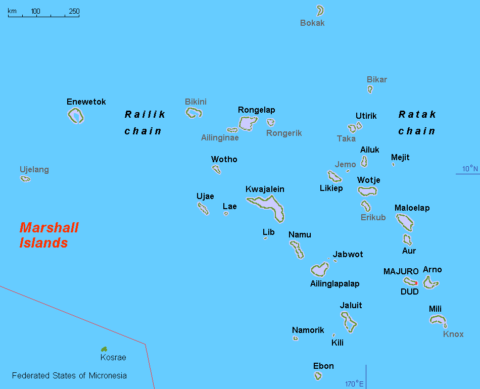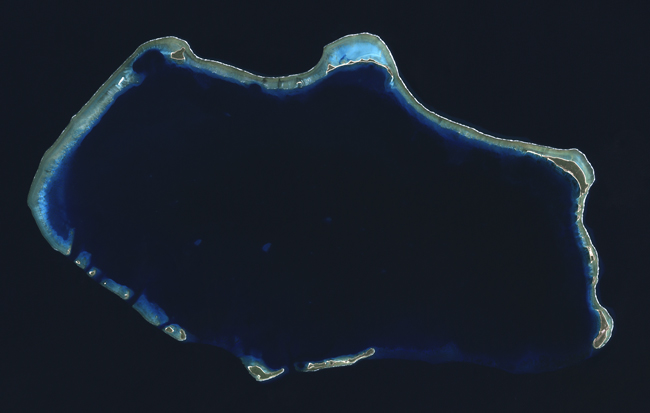Sixty-five years ago, the United States detonated a 15-megaton nuclear device on Bikini Atoll in the Marshall Islands. Nuclear fallout from the Castle Bravo explosion hit nearby populated islands hard and caused significant health and environmental concerns.
Castle Bravo was one of 67 U.S. nuclear tests conducted in the Marshall Islands from 1946 to 1958. A trio of studies published yesterday in Proceedings of the National Academy of Sciences of the United States of America found that in several locations in and near testing sites, ambient radiation levels as well as radioactivity levels in ocean sediments and food remain higher than maximum exposure limits.
Gamma Exposure Across Atolls
From 2015 to 2018, researchers sampled radioactivity levels on islands in four atolls known to have been contaminated.
“Our investigations focused on two atolls where tests were conducted, Bikini and Enewetak, and two atolls where people were living during the testing era,” Ivana Nikolic Hughes told Eos. Nikolic Hughes is a coauthor on the three papers and director of the K=1 Project at Columbia University in New York, which ran the studies.
The two atolls that were populated, Rongelap and Utirik, “received large amounts of fallout, in particular from the [Castle] Bravo test, the largest-ever U.S. test,” she added.

“We measured external gamma radiation, soil radioisotope concentrations, cesium-137 levels in food, and radioisotope concentrations in ocean sediment, particularly inside the Bravo Crater,” she said. The team also collected samples from nearby “pantry islands” where locals might travel to get fruit or fish, as well as “control” islands farther away from the testing grounds for comparison.
The researchers mapped ambient radiation levels on eight islands in the four atolls. External gamma radiation levels were low on some islands in Enewetak Atoll and Utirik Atoll.
However, levels on Bikini Island were nearly twice the radiation exposure limit for relocation agreed on by the U.S. and Marshallese governments in 1994. On Rongelap’s Naen Island they were nearly 3 times the limit.
Soils, Sediments, and Sustenance
Concentrations of radioisotopes in some soil samples also exceeded government limits on Bikini Island, Naen Island, and Enewetak’s Enjebi and Runit Islands. Soils from Majuro Island, the location of the country’s capital and most populous city, did not have any radionuclides, the team found.
At the bottom of Bravo Crater, which is filling with ocean water, radioisotope contamination is much worse. The team collected around 130 sediment cores across the crater. Radiation levels for plutonium-239, plutonium-240, americium-241, and bismuth-207 were orders of magnitude higher than background levels.

Long-lived radioisotopes like plutonium and americium could contaminate the ocean ecosystems for centuries, the team wrote, and could affect coral regrowth and repopulation by bacteria and sea life.
The team found unsafe radioactivity levels not just in the air, soil, and water but in the fruit, too. The radioisotope cesium-137 is easily absorbed by food crops, including coconuts and pandanus, both important commercial crops in the Marshall Islands.
The team found no cesium-137 contamination in fruits from Enewetak and Utirik Atolls, which are both populated. But fruits from Bikini Island and Rongelap Island had levels that exceeded limits set by four governments and the International Physicians for the Prevention of Nuclear War. Cesium-137 contamination in some Marshallese fruits was higher than in foods affected by the Fukushima and Chernobyl nuclear disasters.
Lingering Human Health Concerns
The populations of Bikini Island and Rongelap Island were relocated to other Marshall Islands atolls almost 70 years ago and have yet to be resettled. The new results suggest that “further remediation, such as by using potassium fertilizer, may be necessary to ensure that people could safely return to the islands and eat the local foods,” the team wrote.
“The results paint a complex picture of the current radiological conditions on land and in the ocean” in the Marshall Islands, Nikolic Hughes said. “We hope [these measurements] will be helpful to Marshallese people as they continue to grapple with their nuclear legacy.”
—Kimberly M. S. Cartier (@AstroKimCartier), Staff Writer
Citation:
Cartier, K. M. S. (2019), Marshall Islands nuclear contamination still dangerously high, Eos, 100, https://doi.org/10.1029/2019EO128905. Published on 16 July 2019.
Text © 2019. AGU. CC BY-NC-ND 3.0
Except where otherwise noted, images are subject to copyright. Any reuse without express permission from the copyright owner is prohibited.
Text © 2019. AGU. CC BY-NC-ND 3.0
Except where otherwise noted, images are subject to copyright. Any reuse without express permission from the copyright owner is prohibited.

